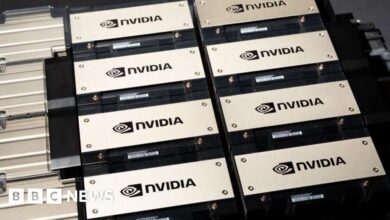Europe’s flying taxi dreams falter as cash runs short
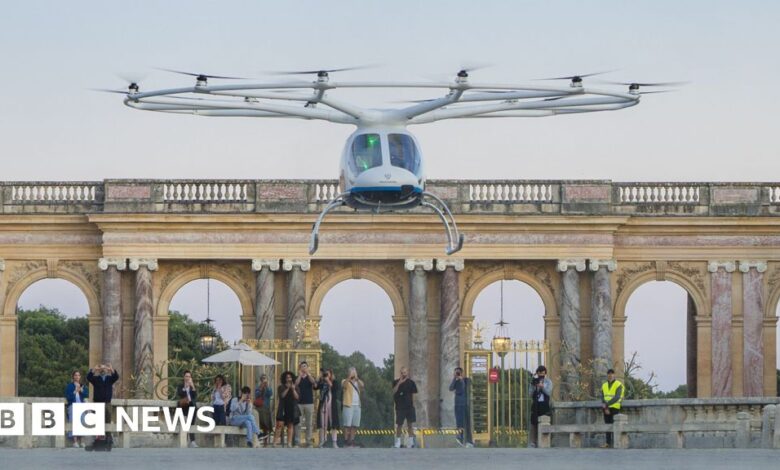
2024-11-15 03:01:23
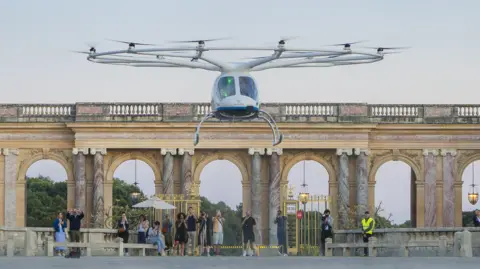 Volocopter
VolocopterOne of the innovations at this year’s Paris Olympics was supposed to be an electric flying taxi service.
Germany’s Volocopter promised its electric-powered, two-seater aircraft, the VoloCity, would be ferrying passengers around the city.
It never happened. Instead the company ran demonstration flights.
While missing that deadline was embarrassing, behind the scenes a more serious issue was playing out – Volocopter was urgently trying to raise fresh investment to keep the firm going.
Talks to borrow €100m (£83m; $106m) from the government failed in April.
Now hopes are pinned on China’s Geely, which is in talks to take an 85% stake in Volocopter in return for $95m of funding, according to a Bloomberg report. The deal could mean that any future manufacturing would be moved to China.
Volocopter is one of dozens of companies around the world developing an electric vertical take-off and landing (EVTOL) aircraft.
Their machines promise the flexibility of a helicopter, but without the cost, noise and emissions.
However, faced with the massive cost of getting such novel aircraft approved by regulators and then building up manufacturing capabilities, some investors are bailing out.
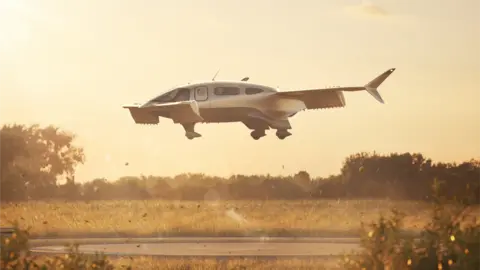 Lilium
LiliumOne of the most high-profile casualties is Lilium.
The German company had developed a radical take on the EVTOL theme.
Lilium’s aircraft uses 30 electric jets that can be tilted in unison to swing between vertical lift and forward flight.
The concept proved attractive, with the company claiming to have orders and memoranda of understanding for 780 jets from around the world.
It was able to demonstrate the technology using a remote controlled scale model. Construction had begun on the first full-sized jets, and testing had been due to begin in early 2025.
As recently as the Farnborough Airshow in July, Lilium’s COO Sebastian Borel was sounding confident.
“We are definitely burning through cash,” he told the BBC. “But this is a good sign, because it means we are producing the aircraft. We’re going to have three aircraft in production by the end of the year, and we have also raised €1.5bn”.
But then the money ran out.
Lilium had been attempting to arrange a loan worth €100m from the German development bank, KfW. However, that required guarantees from national and state governments, which never materialised.
In early November, the company put its main operating businesses into insolvency proceedings, and its shares were removed from the Nasdaq stock exchange.
For the moment, work on the new aircraft is continuing, as the company works with restructuring experts to sell the business or bring in new investment. However, getting the new e-jet into production is looking more challenging than ever.
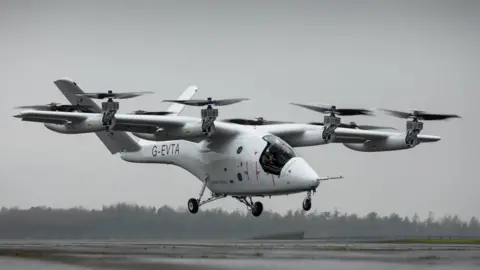 Vertical Aerospace
Vertical AerospaceThe high-profile British player in the eVTOL market is Vertical Aerospace. The Bristol-based company was founded in 2016 by businessman Stephen Fitzpatrick, who also set up OVO Energy.
Its striking VX4 design uses eight large propellers mounted on slim, aircraft style wings to generate lift. Mr Fitzpatrick has made ambitious claims about the aircraft, suggesting it would be “100 times” safer and quieter than a helicopter, for 20% of the cost.
The company has made progress. After completing a programme of remote-controlled testing, it began carrying out piloted tests earlier this year. Initially, these were carried out with the aircraft tethered to the ground. In early November, it carried out its first untethered take-off and landing.
But there have also been serious setbacks. In August last year, a remotely-piloted prototype was badly damaged when it crashed during testing at Cotswold Airport, after a propeller blade fell off.
In May one of its key partners, the engineering giant Rolls Royce pulled out of a deal to supply electric motors for the aircraft.
Ambitions remain sky high. Vertical Aerospace says it will deliver 150 aircraft to its customers by the end of the decade. By then, it also expects to be capable of producing 200 units a year, and to be breaking even in cash terms.
Yet financial strains have been intensifying. Mr Fitzpatrick invested an extra $25m into the company in March. But a further $25m, due in August if alternative investment could not be found, has not been paid. As of September, Vertical had $57.4m on hand – but it expects to burn through nearly double that over the coming year.
Hopes for the future appear to be pinned on doing a deal with the American financier Jason Mudrick, who is already a major creditor through his firm Mudrick Capital Management.
He has offered to invest $75m into the business – and has warned the board of Vertical that rejecting his plan would inevitably lead to insolvency proceedings. But the move has been resisted by Mr Fitzpatrick, who would lose control of the company he founded.
Sources close to the talks insist an agreement is now very close. The company believes if a deal can be done, it will unlock further fundraising opportunities.
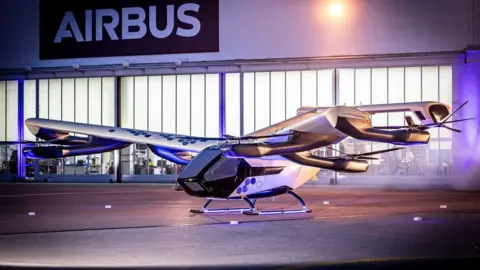 Airbus
AirbusAmid the turbulence, one European project is quietly on track, says Bjorn Fehrm who has a background in aeronautical engineering and piloted combat jets for the Swedish Air Force. He now works for aerospace consultancy Leeham.
He says that the EVTOL project underway at Airbus is likely to survive.
Called the CityAirbus NextGen, the four-seater aircraft has eight propellers and a range of 80km.
“This is a technology project for their engineers, and they’ve got the money, and they’ve got the know how,” says Mr Fehrm.
Elsewhere in the world, other well funded start-ups stand a good change of getting their aircraft into production. That would include Joby and Archer in the US.
Once the aircraft are being produced, the next challenge will be to see if there’s a profitable market for them.
The first routes are likely to be between airports and city centres. But will they make money?
“The biggest problem area when it comes to the cost of operation is the pilot and the batteries. You need to change the batteries a couple of times per year,” points out Mr Fehrm.
Given all the uncertainty and expense, you might wonder why investors put money into new electric aircraft in the first place.
“No one wanted to miss out on the next Tesla,” laughs Mr Fehrm.


